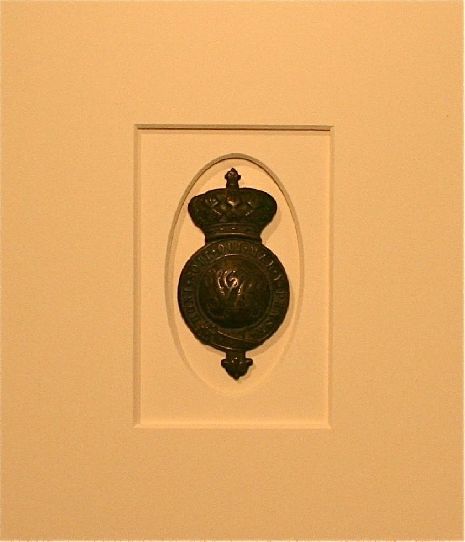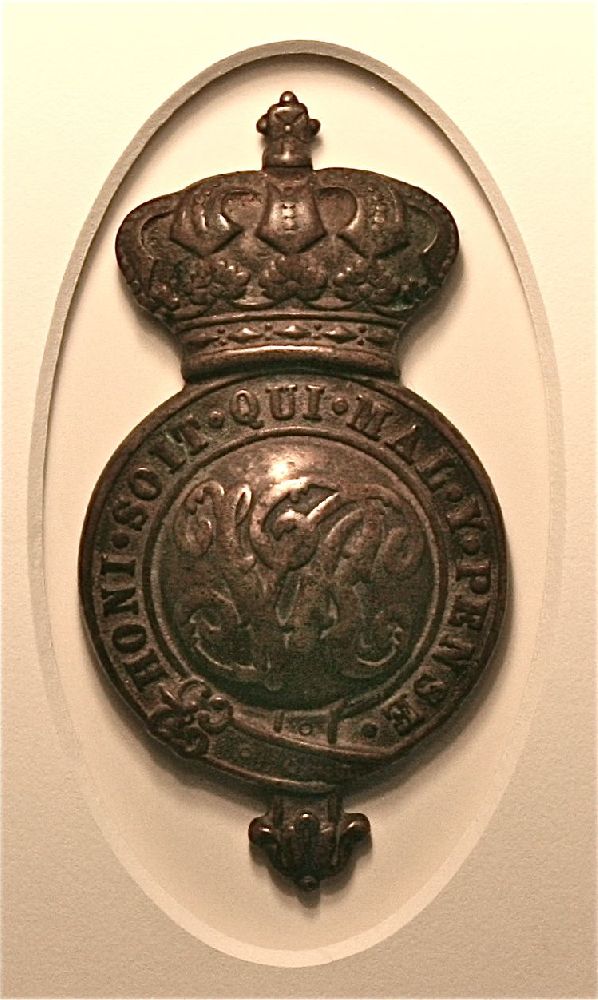
Title: British Royal Military Bronze Garter Badge Honi Soit Qui Mal Y Pense
Catalog Number: 5848
Category: Metals / Metals
Artist:
Country & Origin: Northern Europe > England
Historical Period: 19th Century
Approximate Date: 1857
Signature: Signed
Condition: Museum Quality
Size:
Height: 3 5/8
Width: 2 inches
Depth:
Weight:
Description & Provenance: This is an Antique bronze badge, 7th Queen's Own Hussars coat of arms British Cavalry Badge design! Bit boss, 7th Hussars, c1857. This is in a very old frame, see photos. Membership in the Order is strictly limited and includes the monarch, the Prince of Wales, not more than 24 companion members, and various supernumerary members. The monarch alone can grant membership. He or she is known as the Sovereign of the Garter, and the Prince of Wales is known as a Knight Companion of the Garter. Male members of the Order are titled "Knights Companion," and female members are called "Ladies Companion." Formerly, the Sovereign filled vacancies upon the nomination of the members. Each member would nominate nine candidates, of whom three had to have the rank of Earl or higher, three the rank of Baron or higher, and three the rank of Knight or higher. The Sovereign would choose as many nominees as were necessary to fill any vacancies in the Order. He or she was not obliged to choose those who received the most nominations. Candidates were last nominated in 1860, and appointments have since been made by the Sovereign acting alone, with no prior nominations. The statutes prescribing the former procedure were not amended, however, until 1953. This is an really interesting find, it would be great if someone could find a picture of this attached to the object or horse. "Honi soit qui mal y pense" is a French phrase meaning: "Shamed be he who thinks evil of it". Its literal translation from Old French is "Shame be to him who thinks evil of it". It is sometimes re-interpreted as "Evil be to him who evil thinks". It is the motto of the English chivalric Order of the Garter. An original Martingale -horse brass or bronze badge. With the cypher for Queen Victoria (VR). Several British Army regiments used this motto of the Order of the Garter, including the Royal Horse Artillery, Grenadier Guards , Royal Regiment of Fusiliers , Princess of Wales' Royal Regiment , Life Guards and the Blues and Royals . The Canadian Grenadier Guards , The Royal Regiment of Canada , The Royal Montreal Regiment and New Zealand's 6th Hauraki Infantry Regiment also use it as their mottos. Roughly translated it means " Shame be to him who thinks evil of it." This statement supposedly originated when King Edward III was dancing with his first cousin and daughter-in-law, Joan of Kent. Her garter slipped down to her ankle, causing those around her to snigger at her humiliation. In an act of chivalry Edward placed the garter around his own leg, saying "Honi soit qui mal y pense", and continued "Tel qui s'en rit aujourd'hui, demain s'enhorera de la porter", and the phrase later became the motto of the Order. It may be understood as 'A scoundrel, who thinks badly by it', or 'Shame on him, who suspects illicit motivation'. Followed by "Those who laugh at this today, tomorrow will be proud to wear it." This makes sense of the founding of the Order. Other translations include: "Spurned be the one who evil thinks" and "Evil on him who thinks evil" In British heraldry, the motto Honi soit qui mal y pense is used either as a stand alone motto upon a motto scroll, or upon a circular representation of the garter. Knights and Ladies of the Garter are entitled to encircle the shield of their arms with the garter and motto (e.g. The 1st Duke of Marlborough). The latter usage can also be seen in the Royal coat of arms of the United Kingdom, with the motto of the Royal arms, Dieu et mon droit, being displayed on a scroll beneath the shield. As part of the Royal Arms, the motto is displayed in many public buildings in Britain and colonial era public buildings in various parts of the Commonwealth (such as all Courts of England and Wales). The Royal Arms (and motto) appear on many British government official documents (e.g. the front of current British passports); on packaging and stationery of companies operating under Royal Warrant (e.g. the banner of the Times, which uses the Royal coat of arms of Great Britain circa 1714 to 1800;[8] and are used by other entities so distinguished by the British monarch (e.g. as the official emblem of the Royal Yacht Britannia). Several military organisations in the Commonwealth incorporate the motto inscribed upon a garter of the order within their badges (or cyphers) and some use Honi soit qui mal y pense as their motto. Corps and regiments using the motto in this fashion are ( indicates usage as a motto in addition to inclusion in the badge):
Origin, Encyclopedia & Researched Articles:
Encyclopedia Name: http://en.wikipedia.org/wiki/Order_of_the_Garter
The Most Noble Order of the Garter, founded in 1348, is the highest order of chivalry existing in England and is dedicated to the image and arms of St. George as England's patron saint. It is bestowed on recipients from British and other Commonwealth realms. After peerages (and after the Victoria Cross and George Cross), it is the pinnacle of the honours system in the United Kingdom. Membership in the order is limited to the Sovereign, the Prince of Wales, and no more than twenty-four members, or Companions. The order also includes supernumerary knights and ladies (e.g., members of the British Royal Family and foreign monarchs). Bestowing the honour has been described as one of the Monarch's few remaining truly personal, executive prerogatives.
The order's emblem, depicted on insignia, is a garter with the motto Honi soit qui mal y pense (Middle French: "shame upon him who thinks evil upon it") in gold lettering. Members of the order wear such a garter on ceremonial occasions.
Most British honours encompass the whole United Kingdom, but the topmost three each pertain to one constituent nation. The Order of the Garter, pertaining to England and Wales, is senior in age and precedence; The Most Ancient and Most Noble Order of the Thistle pertains to Scotland; and the now-dormant The Most Illustrious Order of St Patrick pertains to Ireland. New appointments to the Order of the Garter are always announced on St George's Day, 23 April, as Saint George is the patron saint of England.
King Edward III founded the Order of the Garter around the time of his claim to the French throne. The foundation year is usually presumed to be 1348, however, the Complete Peerage, under "The Founders of the Order of the Garter", states the order was first instituted on 23 April 1344, listing each founding member as knighted in 1344, including Sir Sanchet D'Abrichecourt who died on 20 October 1345. Other dates from 1344 to 1351 have also been proposed. The King's wardrobe account shows Garter habits first issued in the autumn of 1348; its original statutes required that each member already be a knight (what would now be referred to as a knight bachelor) and some of the initial members were only knighted that year. The concept was followed over the next century or so with other European monarchs founding their own prestigious orders of chivalry.
The Order of the Garter is the oldest and most prestigious order of chivalry in the United Kingdom.
Various legends account for the origin of the Order. The most popular legend involves the "Countess of Salisbury" (either Edward's future daughter-in-law Joan of Kent or her former mother-in-law, Catherine Montacute, Countess of Salisbury). While she was dancing at a court ball at Calais, her garter is said to have slipped from her leg. When the surrounding courtiers sniggered, the king picked it up and returned it to her, exclaiming, "Honi soit qui mal y pense," ("Shamed be the person who thinks evil of it."), the phrase that has become the motto of the Order. According to another legend, King Richard I was inspired in the 12th century by St George the Martyr while fighting in the Crusades to tie garters around the legs of his knights, who subsequently won the battle. King Edward supposedly recalled the event in the 14th century when he founded the Order. Another explanation is that the motto refers to Edward's claim to the French throne, and the Order of the Garter was created to help pursue this claim. The use of the garter as an emblem may have derived from straps used to fasten armour.
Medieval scholars have pointed to a connection between the Order of the Garter and the Middle English poem, "Sir Gawain and the Green Knight". In "Gawain", a girdle, very similar in its erotic undertones to the garter, plays a prominent role. A rough version of the Order's motto also appears in the text. It translates from Old French as "Accursed be a cowardly and covetous heart." While the author of that poem remains disputed, there seems to be a connection between two of the top candidates and the Order of the Garter. Scholar J.P. Oakden has suggested that it is someone related to John of Gaunt, 1st Duke of Lancaster, and, more importantly, a member of the Order. Another competing theory is that the work was written for Enguerrand de Coucy, seventh Sire de Coucy. Sire de Coucy was married to King Edward III's daughter, Isabella, and was given admittance to the Order of the Garter on their wedding day.
Soon after the founding of the Order, women were appointed "Ladies of the Garter," but were not made companions. King Henry VII discontinued the practice in 1488; his mother, Margaret Beaufort, was the last Lady of the Garter before Queen Alexandra. Except for female sovereigns, the next Lady of the Garter named was Queen Alexandra, by her husband King Edward VII. King George V also made his consort, Queen Mary, a Lady of the Garter and King George VI subsequently did the same for his wife, Queen Elizabeth. Throughout the 20th century, women continued to be associated with the Order, but except for foreign female monarchs, they were not made companions. In 1987, however, it became possible to install "Ladies Companion of the Garter" under a statute of Elizabeth II.
From the 18th century, the Sovereign made his or her choices on the advice of Government. However, King George VI believed that the Order of the Garter and the Order of the Thistle had become too linked with political patronage. In 1946, with the agreement of the Prime Minister Clement Attlee and the Leader of the Opposition Winston Churchill, membership to these two orders became a personal gift of the Sovereign once again. Thus, the Sovereign personally selects Knights and Ladies Companion of the Garter, and need not act on or solicit the advice of His or Her Government.
Verbal History:
7th Queen's Own Hussars:
In 1689 the Scottish army raised 12 independent cavalry troops, half of which were merged into a single regiment on the English establishment in 1690 for policing duties in Scotland. This new unit was named the Queen’s Own Regiment of Dragoons after the recently enthroned Mary II.
The regiment’s first 25 years included two deployments to the Low Countries and ten years on the Scottish establishment. It was disbanded for ten months from April 1714 and February 1715, before facing the Jacobite rebels at Sherrifmuir nine months after its re-formation. 1715 also saw it renamed ‘The Princess of Wales’s Own’ after Caroline, consort of the future George II, though it returned to being ‘The Queen’s Own’ in 1727 when George acceded to the throne.
The unit was then out of action for 27 years, until it re-mobilised in 1742 and charging at both Dettingen and Fontenoy. It moved back to Scotland in 1756 and added a light troop, which was used in the late 1750s in raids on northern French ports. The regiment as a whole fought at Warburg in 1760 before entering another 30 years’ home service before the French Revolutionary Wars. They deployed to the Netherlands in 1794 and 1799 before ten years in Britain. In 1801 Henry Paget, 1st Marquess of Anglesey, became the regiment’s colonel and he remained in the role until 1842, even after losing a leg at Waterloo (1815).
Paget also gained the regiment an upgrade to hussars in 1807, the second-ever British regiment to gain that honour. It served in Spain in 1808 and 1813, spending the interim recruiting after severe losses. It was also heavily engaged at Waterloo, charging more than 12 times in four hours and losing 64 killed and 120 wounded.
It then saw no more action until the Indian Mutiny in 1857, where it won its first and second Victoria Crosses. It remained in India until 1871. The 7th spent the next 46 years in England and South Africa, along with a total of 18 years in India. They only joined the First World War in 1917, when they were deployed to Basra and Baghdad against the Ottoman Turks.
The unit remained in Iraq on occupation duties until May 1919. The inter-war period saw it in India, England and Egypt, during which time it also mechanised, in 1936. The 7th's Second World War service began in North Africa from 1940 to 1942, when it redeployed to cover the retreat through Burma, fighting the last 150 miles as infantry after having to destroy its tanks. It then re-equipped in Egypt before fighting alongside 2nd Polish Corps in Italy for the last two years of the war, for which it gained the honour of wearing the crest of the city of Warsaw on its sleeve.
It served as occupation troops in Germany twice during the late 1940s before becoming the first armoured unit to deploy to Hong Kong in 1954. It kept order there during the 1956 riots, returned to Britain in 1957 and a year later amalgamated with the 3rd Hussars to form the Queen’s Own Hussars.












Comments are subject to review
Be the first to comment!